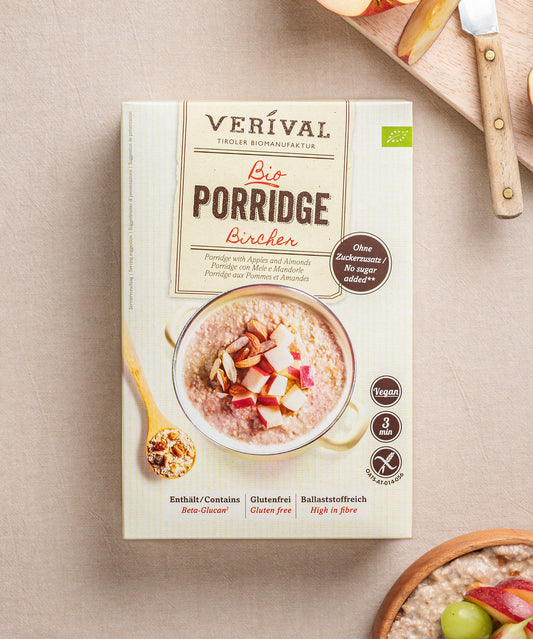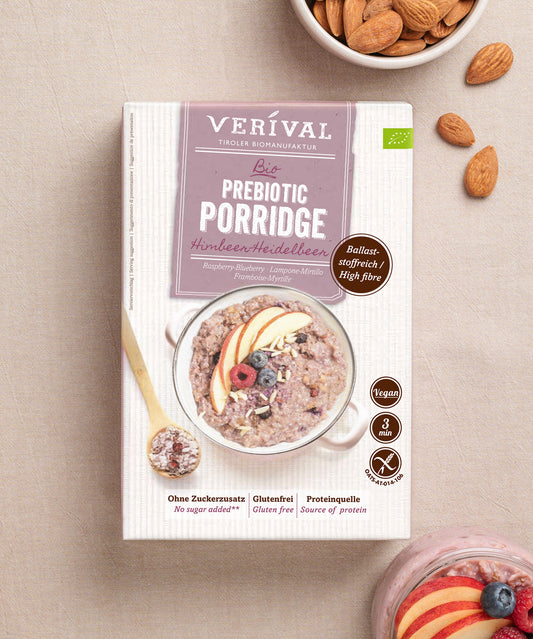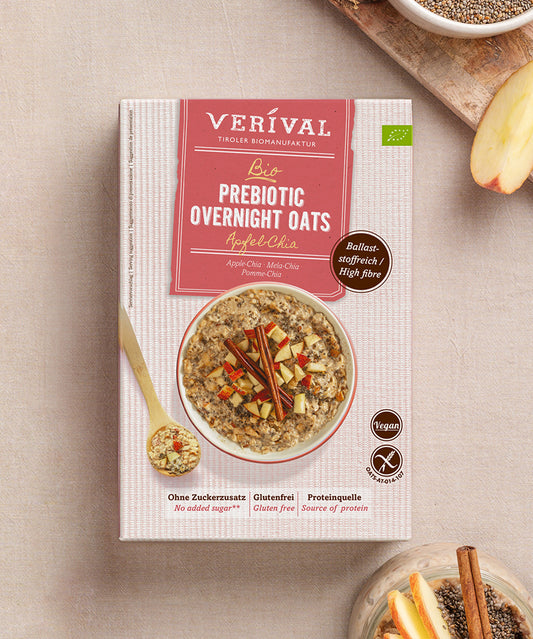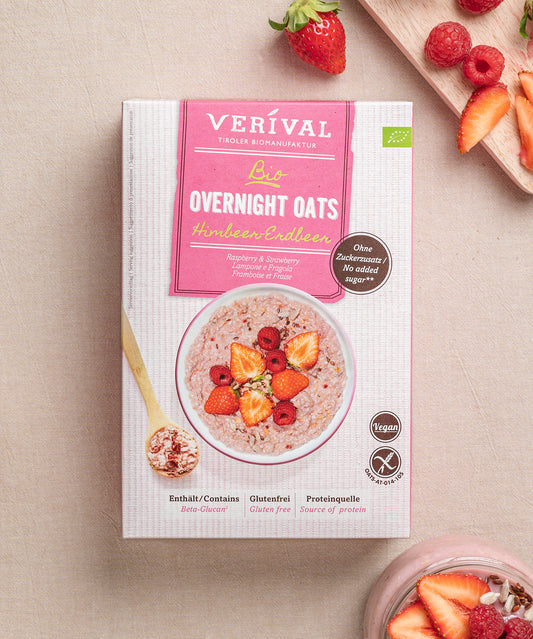Blood sugar – a topic that keeps many people on their toes. Diseases and the associated control are becoming more and more common. Maintaining stable blood sugar levels is crucial for good health, especially for people with diabetes. However, proper control of blood sugar can be beneficial for everyone to reduce the risk of diabetes and other metabolic disorders. Today, we will take a close look at the foods that can stabilize blood sugar levels. From the basics of blood sugar levels to practical tips for everyday life, we will cover all aspects of this important topic. So you don't become a passenger of your blood sugar balance!
Do you love breakfast? So do we! Check out our entire product range here!
Basics of blood sugar and blood sugar levels
A solid understanding of the basics of blood sugar is crucial to grasping its importance to health. Blood sugar levels, also known as blood sugar values, are the concentration of glucose in the blood and serve as the body's main source of energy. Stable blood sugar levels are necessary to ensure adequate functioning of various organs and tissues. Imbalances in blood sugar, whether due to excessively high (hyperglycemia) or low (hypoglycemia) levels, can cause serious health problems, including diabetes and other metabolic disorders.
There are two main forms of diabetes: type 1 and type 2. In type 1 diabetes, the immune system attacks the insulin-producing cells in the pancreas, leading to absolute insulin deficiency. Type 2 diabetes, on the other hand, is characterized by insulin resistance, in which the body's cells no longer respond as well to insulin, resulting in relative insulin deficiency. Insulin is a hormone produced by the pancreas that regulates blood sugar by transporting glucose from the blood into cells, where it is used for energy. Insulin resistance causes cells to stop responding appropriately to insulin, leading to an increase in blood sugar levels. A thorough understanding of these basics is key to effectively managing blood sugar levels and promoting overall health.
Explanation of blood sugar levels and their importance
Blood glucose, also known as blood sugar, is an essential parameter of the body's health. It indicates the concentration of glucose in the blood, which serves as the body's main source of energy. Stable blood sugar levels are crucial to ensure the proper functioning of various organs and tissues. Blood sugar levels that are too high or too low can cause serious health problems.
Hyperglycemia occurs when blood sugar levels are too high, which can happen with untreated diabetes. This can cause symptoms such as increased thirst, frequent urination, fatigue, and blurred vision. In the long term, untreated hyperglycemia can lead to complications such as heart disease, kidney damage, and neuropathy.
On the other hand, hypoglycemia can occur when blood sugar levels are too low. This can be caused by too much insulin or certain medications. Symptoms such as tremors, sweating, confusion, and unconsciousness occur if left untreated.
The importance of stable blood sugar levels cannot be overstated. They are directly linked to overall health and well-being. By eating well, engaging in regular physical activity and maintaining a healthy lifestyle, stable blood sugar levels can be achieved. This leads to an improved quality of life and reduced risk of diabetes and other metabolic disorders.
Blood sugar: differences between type 1 and type 2 diabetes
Type 1 diabetes is an autoimmune disease in which the immune system attacks the insulin-producing cells in the pancreas. This leads to an absolute insulin deficiency. This form often occurs at a young age and requires lifelong insulin therapy.
In contrast, type 2 diabetes is characterized by insulin resistance, in which the body's cells are less responsive to insulin, resulting in relative insulin deficiency. This form is more common in adulthood and can be controlled by a healthy diet, regular exercise, and weight management, although medication is sometimes also required.
It is important to distinguish between the two forms of diabetes because they have different causes, treatment approaches, and long-term effects. A sound understanding of these differences is crucial for effectively managing and treating the disease.
Role of insulin and insulin resistance
Insulin is a vital hormone produced by the pancreas that regulates blood sugar levels. Its main function is to transport glucose from the blood into the cells, where it is used for energy. In insulin resistance, the body's cells no longer respond appropriately to insulin, leading to an increase in blood sugar levels. This can lead to further complications, such as an increased risk of type 2 diabetes, heart disease and obesity.
nsulin resistance can be improved with a healthy diet, regular physical activity and weight management. It is important to understand the role of insulin and insulin resistance in order to recognize the importance of a healthy lifestyle in preventing and treating metabolic disorders.
These foods will help you keep your blood sugar levels stable
Foods that stabilize blood sugar
Choosing the right foods plays a crucial role in maintaining stable blood sugar levels. Some foods have been shown to be particularly effective at stabilizing blood sugar levels and improving insulin sensitivity.
High-fiber foods such as whole grains, legumes, vegetables, and fruits help to slow the rise in blood sugar after meals while providing long-lasting satiety. Proteins from lean meat, fish, chicken, eggs and dairy products can also help stabilize blood sugar levels by delaying glucose absorption and improving insulin sensitivity.
Healthy fats, such as those found in avocados, nuts and seeds, can also help keep blood sugar levels stable by helping to reduce blood sugar spikes after meals and improving insulin sensitivity.
Eating foods with a low glycemic index, such as non-starchy vegetables, whole grains and legumes, can also help keep blood sugar levels stable.
By incorporating these foods into your diet and aiming for a balanced meal composition, you can help keep your blood sugar levels stable and minimize your risk of diabetes and other metabolic disorders.
Whole grain products
Whole grain products such as oats, whole grain bread, quinoa and brown rice are excellent options for keeping blood sugar levels stable. Their high fiber content slows the digestion and absorption of glucose in the blood, resulting in a slower rise in blood sugar levels. Compared to refined carbohydrates, whole grains provide long-lasting satiety and energy, which is especially important for avoiding food cravings and blood sugar spikes.
In addition, whole grain products also contain a variety of nutrients, including vitamins, minerals and antioxidants, which contribute to overall health. By regularly consuming whole grain products, people can not only better control their blood sugar levels, but also reduce their risk of cardiovascular disease, obesity and type 2 diabetes.
Wholegrain products offer a versatile and delicious way to promote a balanced diet while supporting good health. By incorporating wholegrain products into their diet, people can stabilize their blood sugar levels and promote optimal long-term health.
Discover the full range of Verival porridges here!
Pulses
Legumes such as beans, lentils and chickpeas are valuable foods for stabilizing blood sugar levels. Their high fiber and protein content helps to slow the rise in blood sugar after meals and promotes long-lasting satiety. Fiber slows the digestion and absorption of carbohydrates, which helps to keep blood sugar levels stable and avoid food cravings.
In addition, legumes contain complex carbohydrates that cause blood sugar levels to rise slowly, ensuring a constant supply of energy. Their high protein content also helps to stabilize blood sugar levels, as proteins can slow glucose absorption and improve insulin sensitivity.
Legumes are versatile and can be used in a variety of dishes, including soups, stews, salads and curries. By regularly incorporating legumes into their diet, people can stabilize their blood sugar levels, improve satiety and promote heart health.
Citrus fruits and antioxidants
Citrus fruits such as oranges, lemons and grapefruits are not only refreshing and delicious, but also nutritious and can help stabilize blood sugar levels. They are rich in vitamin C and also contain a variety of antioxidants such as flavonoids, which have anti-inflammatory properties and can protect cells from damage by free radicals.
The antioxidants they contain can help keep blood sugar levels stable by improving insulin sensitivity and aiding the uptake of glucose from the blood into cells. Furthermore, citrus fruits can help lower blood sugar levels after meals, especially when consumed as part of a balanced meal that also includes other high-fiber and protein-rich foods.
Citrus fruits are easy to incorporate into your diet and can be enjoyed in a variety of ways, whether as a snack, in a salad, as a juice or as an ingredient in various dishes. By regularly consuming citrus fruits, people can stabilize their blood sugar levels, promote overall health and reduce the risk of chronic diseases.
Blood sugar: Other recommended foods
In addition to whole grains, legumes, and citrus fruits, there are a variety of other foods that can help keep blood sugar stable and promote good health.
Garlic and ginger are not only popular spices, but are also known for their anti-inflammatory properties and ability to improve insulin sensitivity. You can easily incorporate them into a variety of recipes, and they offer the perfect way to keep your blood sugar levels constant.
Certain fruits, such as apples and berries, are high in fiber, vitamins, and antioxidants and can help control blood sugar levels when enjoyed in moderation.
Green leafy vegetables such as spinach, kale, and Swiss chard are also good options because they are low in carbohydrates but high in vitamins, minerals, and antioxidants. These foods can help keep blood sugar levels stable and reduce the risk of chronic disease.
Protein sources such as lean meat, low-fat dairy products and legumes can also help stabilize blood sugar levels and promote satiety. By incorporating these foods into their diet, people can better control their blood sugar levels and promote their long-term health.
Blood sugar: Avoiding certain foods
An important step in maintaining stable blood sugar levels is to avoid certain foods that can cause blood sugar to rise rapidly. These foods include those with a high glycemic index, which cause blood sugar levels to rise quickly.
White bread, sugar, dextrose and honey are some of the main culprits for a rapid increase in blood sugar levels. These foods contain simple sugars that you digest quickly. This causes your blood sugar level to rise rapidly. Sweets such as chocolate, candies and pastries should also be enjoyed in moderation. They often contain large amounts of added sugars.
Sugar-sweetened beverages, including sodas, iced teas, and energy drinks, should also be avoided. Even supposedly healthy beverages such as fruit juices can have a high sugar content and cause blood sugar levels to rise quickly. It is advisable to prefer water, unsweetened tea or sugar-free drinks instead.
By avoiding these high-sugar foods, you can prevent blood sugar spikes and achieve stable blood sugar control. It is important to pay attention to the nutritional information on food labels. It is also important to be aware of which foods can quickly raise blood sugar levels. Instead, choose foods that you digest slowly so that your blood sugar level remains stable.
Exercise helps with blood sugar problems
Practical tips for everyday life
Controlling blood sugar levels requires not only choosing the right foods, but also a healthy lifestyle. Here are some practical tips for keeping blood sugar levels at a healthy level:
Incorporate blood sugar-friendly foods into your diet
Plan meals that are rich in blood sugar-friendly foods such as whole grains, vegetables, lean proteins and healthy fats. This can help keep blood sugar levels stable and maintain energy throughout the day.
Blood sugar and the importance of physical activity
Regular physical activity is crucial for maintaining healthy blood sugar levels. Both endurance and strength training can help improve insulin sensitivity and lower blood sugar levels.
Regular blood sugar monitoring
People with diabetes should regularly monitor their blood sugar levels to ensure that they are within a healthy range. This can help to make adjustments to diet and insulin dosage to control blood sugar levels and prevent complications.
Breakfast without added sugars is important to us. Discover our range here!
Blood sugar: a conclusion
Stabilizing blood sugar levels is crucial to maintaining optimal health. You can achieve stable blood sugar levels by choosing blood sugar-friendly foods and avoiding foods that are high in sugar.
In addition to diet, regular physical activity and blood sugar monitoring play an important role. An active lifestyle improves insulin sensitivity and helps control blood sugar levels.
It is also important to be aware that blood sugar control is not only important for people with diabetes. It is important for everyone to reduce the risk of diabetes and other metabolic disorders.
By incorporating blood sugar-friendly foods into their diet, engaging in regular physical activity and consciously monitoring their blood sugar levels, people can improve their long-term health and lead active, fulfilling lives.
Frequently asked questions
How can I lower my blood sugar quickly?
To lower your blood sugar quickly, you can use fast-acting insulin, exercise, walk briskly, or drink sugar-free drinks to dilute your blood sugar.
How long does it take for blood sugar to return to normal?
The time it takes for blood sugar to normalize varies from person to person. However, it usually takes about one to two hours after a meal for blood sugar to return to normal levels.
How do I get blood sugar down quickly?
You can lower blood sugar quickly by taking fast-acting insulin or by engaging in physical activity such as brisk walking to speed up glucose metabolism.
What should I eat in the evening to lower my blood sugar?
In the evening, it's best to choose foods with a low glycemic index, such as vegetables, lean proteins and whole grains, to keep blood sugar stable.
How can walnuts and oats help stabilize blood sugar levels?
Walnuts and oats contain fiber and healthy fats that can help stabilize blood sugar levels and reduce insulin spikes after meals.
What role do legumes play in avoiding blood sugar fluctuations?
Legumes are high in fiber and protein, which can help stabilize blood sugar levels and reduce blood sugar fluctuations by slowing glucose absorption.
Why is fast food particularly harmful for people with diabetes mellitus?
Fast food often contains high amounts of saturated fat, trans fat, salt, and added sugar, which can rapidly raise blood sugar and increase the risk of diabetes complications.
Which foods are best for balancing blood sugar levels?
Foods with a low glycemic index, such as whole grains, non-starchy vegetables, lean proteins and healthy fats, are the best way to balance blood sugar levels.
Can you control type 2 diabetes with diet alone?
A healthy diet alone can help control type 2 diabetes and stabilize blood sugar levels. However, a combination of diet, exercise and, if necessary, medication is often also required.
How does physical activity affect blood sugar levels?
Physical activity can improve insulin sensitivity and increase glucose uptake in muscle cells, resulting in lower blood sugar levels.
Why should you avoid white bread and fruit juices?
White bread and fruit juices have a high glycemic index, which can quickly raise blood sugar levels. They contain a lot of processed sugar and little fiber, which can lead to blood sugar spikes.
How can I effectively measure my blood sugar level?
You can effectively measure your blood sugar level with a blood glucose meter by placing a drop of blood from your finger on a test strip plate and inserting it into the meter.
What is hypoglycemia?
Hypoglycemia, also known as low blood sugar, occurs when blood sugar levels are too low.
This can cause symptoms such as shaking, sweating, confusion and fainting.
What should you do in case of low blood sugar?
If you have low blood sugar, you should eat or drink fast-acting carbohydrates such as glucose or fruit juice to raise your blood sugar quickly. If the symptoms are severe or do not go away, you should seek medical attention.
























